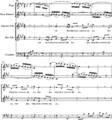Canon (music) facts for kids
- For other meanings of the word "canon" see canon.
A canon is a special type of musical piece. It's like a musical chase! Different voices or instruments play the exact same tune. But they start at different times, one after the other. Imagine singing a song, and then your friend starts singing the same song a few seconds later. That's how a canon works!
A round is a very common kind of canon. In a round, like "Row, Row, Row Your Boat," each singer can keep repeating the tune from the beginning. This makes the music go "round and round" forever! One of the most famous canons ever is the Pachelbel Canon. It was written by a composer named Johann Pachelbel.
Contents
What Are the Different Kinds of Canons?
Canons can be described in a few ways. One way is by how far apart the voices start.
Canons by Starting Time
If the second voice starts one bar (or measure) after the first, it's called a "canon at the bar." If it starts after only half a bar, it's a "canon at the half-bar." Some canons can be very close, like a "canon at the quaver" (which is an eighth note).
The composer Olivier Messiaen wrote a three-part canon like this. It was for violin and piano. The pianist's right hand, left hand, and the violinist all played parts.
Canons by Musical Changes
Canons can also be described by the intervals (musical distances) between the voices.
- Canon at the Fourth: If one voice starts on a C note and the next voice starts the same tune on an F note, it's a "canon at the fourth." This is because the distance from C to F is called a "perfect fourth."
- Canon in Inversion: Sometimes, the second voice plays the tune "upside down." This means if the first voice goes up, the second voice goes down. This is called a "canon in inversion."
- Canon in Augmentation: If the second voice plays the tune at half the speed (each note lasts twice as long), it's a "canon in augmentation."
- Canon in Diminution: The opposite of augmentation is "canon in diminution." Here, the notes are played twice as fast.
Strict vs. Free Canons
A "strict canon" means that every voice copies the first voice exactly, all the way through the piece. If the music starts like a canon but then becomes more free, it's called a "free canon."
Canons might sound a bit like a fugue at the beginning. However, fugues have their own special rules and structure.
Canons Through Music History
Canons were very popular way back in the 14th century. Composers loved writing music where several voices shared the melody. This style is called polyphonic music. Composers like Guillaume de Machaut wrote canonic music. One of his pieces, Sanz cuer m’en vois, was a three-part canon where each part had different words.
Johann Sebastian Bach's Canons
Perhaps the greatest composer of canons in the 1700s was Johann Sebastian Bach. Many of his organ pieces include canons. He wrote a famous set called Canonic Variations on "Vom Himmel hoch da komm' ich her". This piece has several canons that use different intervals and inversions. Bach probably wrote it to teach young composers how to create good canons.
Bach also wrote a work called the Musical Offering. It includes a "canon per augmentationem contrario motu." This means it's a canon in augmentation (slower notes) and contrary motion (backwards). He also wrote a "canon per tonos." This is a special type of canon where the tune changes key. It's very tricky to compose well!
Bach was a true master at writing canons and other complex musical forms.
Canons After Bach
After 1750, composers became less focused on music that was entirely polyphonic. However, many still used counterpoint in their works. Famous composers like Haydn, Mozart, and Beethoven all wrote canons. Even Romantic composers such as Schumann and Brahms showed interest in them.
César Franck wrote a canon in the fourth movement of his Sonata for Violin and Piano. It's quite easy to hear this canon. The violin plays the tune an octave higher than the piano. The piano holds a long note every other bar while the violin catches up.
Canons in the 20th Century
In the 20th century, composers like Schoenberg enjoyed using canons in their serial music. Modern composers, such as Pierre Boulez, have even written rhythmic canons. In these, the rhythm of one part might be the backwards version of another part.
Images for kids
See also
 In Spanish: Canon (música) para niños
In Spanish: Canon (música) para niños






